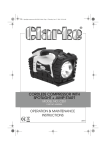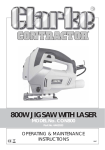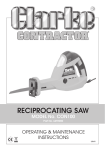Download Clarke CON300 Specifications
Transcript
VARIABLE SPEED JIG SAW ELECTRIC SANDER Part No. 6460200 MODEL No. CON300 Part No. 6462052 OPERATING & MAINTENANCE INSTRUCTIONS 1 LS0610 2 Thank you for purchasing this CLARKE Sander. Before attempting to use the sander, please read this manual thoroughly and follow the instructions carefully. In doing so you will ensure the safety of yourself and that of others around you, and you can look forward to the sander giving you long and satisfactory service. GUARANTEE This product is guaranteed against faulty manufacture for a period of 12 months from the date of purchase. Please keep your receipt which will be required as proof of purchase. This guarantee is invalid if the product is found to have been abused or tampered with in any way, or not used for the purpose for which it was intended. Faulty goods should be returned to their place of purchase, no product can be returned to us without prior permission. This guarantee does not effect your statutory rights. PACK CONTENTS • CON300 Electric sander • 4 x 60 Grit Sanding Sheets • 3 x 120 Grit Sanding Sheets • 3 x 240 Grit Sanding Sheets SPECIFICATIONS Model ........................................................ CON300 Part No ....................................................... 6462052 Electrical Supply ....................................... 230V 50Hz 1 ph Wattage .................................................... 330 W No Load Speed ........................................ 6000 - 11000 Orbits per minutes Sanding pad size ...................................... 230 mm x 115 mm Weight (unpacked) ................................. 2.62 kg Dimensions ................................................ 340 x 120 x 195 mm Sound Pressure Level LPA ............................................. 84.5 dB(A) Sound Power Level LWA ................................................. 95.5 dB(A) Please note that the details and specifications contained herein, are correct at the time of going to print. However, CLARKE International reserve the right to change specifications at any time without prior notice. 3 SAFETY PRECAUTIONS WARNING! As with all machinery, there are certain hazards involved with their operation and use. Exercising respect and caution will considerably lessen the risk of personal injury. However, if normal safety precautions are overlooked or ignored, personal injury to the operator or damage to property, may result. 1. ALWAYS Learn the machines’ applications, limitations and the specific potential hazards peculiar to it. Read and become familiar with the entire operating manual. 2. ALWAYS use a face or dust mask if sanding operation is particularly dusty. 3. ALWAYS check for damage. before using the machine, any damaged part, should be checked to ensure that it will operate properly, and perform its intended function. Check for alignment of moving parts, breakage of parts, mountings, and any other condition that may affect the machines’ operation. Any damage should be properly repaired or the part replaced. If in doubt, DO NOT use the machine. Consult your local dealer. 4. ALWAYS disconnect the tool/machine from the power supply before servicing and when changing accessories. 5. ALWAYS wear safety goggles, manufactured to the latest European Safety Standards. Everyday eyeglasses do not have impact resistant lenses, they are not safety glasses. 6. ALWAYS keep work area clean. Cluttered areas and benches invite accidents. 7. ALWAYS ensure that adequate lighting is available. A minimum intensity of 300 lux should be provided. Ensure that lighting is positioned so that you will not be working in your own shadow. 8. ALWAYS keep children away. All visitors should be kept a safe distance from the work area, especially whilst operating the machine. 9. ALWAYS maintain machine in top condition. Keep tools/machines clean for the best and safest performance, follow maintenance instructions. 10. ALWAYS handle with extreme care do not carry the tool/machine by its’ electric cable, or yank the cable to disconnect it from the power supply . 11. ALWAYS ensure the switch is off before plugging in to mains. Avoid accidental starting. 12. ALWAYS concentrate on the job in hand, no matter how trivial it may seem. Be aware that accidents are often caused by carelessness due to familiarity. 13. ALWAYS keep your proper footing and balance at all times - don’t overreach. For best footing, wear rubber soled footwear. Keep floor clear of oil, scrap wood, etc. 14. ALWAYS wear proper apparel. Loose clothing or jewellery may get caught in moving parts. Wear protective hair covering to contain long hair. 4 15. ALWAYS use recommended accessories. The use of improper accessories could be hazardous. 16. ALWAYS remove plug from electrical outlet when adjusting, changing parts, or working on the machine. 17. NEVER operate machine while under the influence of drugs, alcohol or medication. 18. NEVER leave machine running unattended. Turn power off. Do not leave the machine until it comes to a complete stop. 19. NEVER force the machine. It will do a better and safer job at the rate for which it was designed. 20. NEVER use power tools in damp or wet locations or expose them to rain. Keep your work area well illuminated. do not use in explosive atmosphere (around paint fumes, flammable liquids etc.). Avoid dangerous environment. ADDITIONAL PRECAUTIONS FOR ORBITAL SANDERS 1. 2. 3. 4. 5. 6. 7. Always wear ear protectors/defenders, as the noise level of this machine can exceed 85dB (A). Do not use the machine if the electric cable, plug or the motor, is in poor condition. Keep the mains cable well away from the sander, and ensure an adequate electrical supply is close at hand so that the operation is not restricted by the length of the cable. Switch the machine OFF immediately the task is completed. Never allow the ventilation slots in the machine to become blocked. Always use the appropriate sanding medium for the material being worked. Both metal and wood sanding sheets of various grades are available from all good hardware stores. Do not attempt any electrical repair yourself. Consult a qualified electrician, or our Service Department on 020 8988 7400 Additionally, please keep these instructions in a safe place for future reference. DUST EXTRACTION The sander is provided with a dust extraction facility, Please note however, that this does not preclude the user from wearing a face mask to prevent the inhalation of dust particles. It is an EEC requirement that a dust extraction facility be provided on power tools, however, due to the nature of the tool, some of the dust produced will be forced into the surrounding atmosphere, and will not be collected. 5 ELECTRICAL CONNECTIONS This product is provided with a standard 13 amp, 230 volt (50Hz), BS 1363 plug, for connection to a standard, domestic electrical supply. Should the plug need changing at any time, ensure that a plug of identical specification is used. WARNING! This appliance is double insulated, and the two wires in the mains lead should be wired in accordance with the following colour code: BLUE - NEUTRAL BROWN - LIVE • Connect the BLUE coloured wire to the plug terminal marked with a letter “N” • Connect the BROWN coloured wire to the plug terminal marked with a letter “L” If this appliance is fitted with a plug which is moulded on to the electric cable (i.e. non-rewireable) please note: 1. The plug must be thrown away if it is cut from the electric cable. There is a danger of electric shock if it is subsequently inserted into a socket outlet. 2. Never use the plug without the fuse cover fitted. 3. Should you wish to replace a detachable fuse carrier, ensure that the correct replacement is used (as indicated by marking or colour code). 4. Replacement fuse covers can be obtained from your local Clarke dealer or most electrical stockists. FUSE RATING The fuse in the plug must be replaced with one of the same rating (5 amps) and this replacement must be ASTA approved to BS1362. If in doubt, consult a qualified electrician. Do not attempt any electrical repairs yourself. CABLE EXTENSION Always use an approved cable extension suitable for the power rating of this tool (see specifications), the conductor size should also be at least the same size as that on the machine, or larger. When using a cable reel, always unwind the cable completely. If using tool outdoors, only use extension cables intended for outdoor use. PREPARATION WARNING! Disconnect the plug from the power source before fitting/changing the sandpaper. FITTING THE SANDPAPER To fit the sandpaper, proceed as follows: 1. Lift the clamp lever, see figure 1. 2. Insert the end of the sandpaper and push the clamp lever down. 3. Fold the sandpaper around the vibrating plate, ensuring the holes on the sandpaper are aligned with the holes on the vibrating plate, see figure 2. 4. Insert and clamp the other end of the sandpaper to the other end of the sander. Fig 1 Clamp Lever Fig 2 Clamp Lever WARNING! When using the orbital sander, certain materials will generate harmful or toxic dusts and grit. Contact with or inhalation of these dusts can endanger the health of the operator and bystanders, see general safety rules for appropriate personal protective equipment. OPERATION 1. Connect the plug to the mains supply socket and switch on. 2. Hold the sander firmly with both hands. OPERATING THE TRIGGER SWITCH WARNING! Never start the sander when it is in contact with the work piece. 1. Hold the sander in mid air and squeeze the trigger, the sander will start. Fig 3 Handle Lock-on button 2. Release the trigger to stop the sander. 3. If continuous operation is required, squeeze the trigger, and depress the lock-on button and release the trigger. 4. To stop the sander, squeeze the trigger to release the lock-on button, then release the trigger. Trigger WARNING! After Use, ensure that the sander has stopped before putting the tool down. 8 OPERATION USING THE SANDER 1. Make sure that there are no nails or other objects in the area to be sanded. 2. Let the sander reach full speed before applying it to the work surface. 3. Do not apply pressure to the sander during use. The weight of the sander alone is sufficient for normal use. 4. Move the sander evenly over the work area. Do not allow the sander to stay in one place for too long. 5. Replace worn sanding sheets. The performance of your sander is dependant on the quality of the sanding sheets being used. Replacement sanding sheets are available from your CLARKE dealer (see page 13). 6. Remove the sander from the work area before releasing the trigger. SANDING HINTS • Always use both hands to hold the sander Fig 4 • Clamp the workpiece for added stability and safety. DUST EXTRACTION PORT Fig 5 You can connect a vacuum cleaner directly to the dust extraction port. • The extraction port has an internal diameter of 30mm and an external diameter of 37mm Dust Extraction Port 9 MAINTENANCE WARNING! Make sure that the sander is switched off and disconnected from the mains supply before starting any cleaning or maintenance procedures. • Keep the cooling vents clear. • Clean the housing with a soft cloth. • Any worn or damaged parts should be replaced by qualified personnel. • Keep the handles clean and free from oil and grease. • There are no user serviceable parts inside this sander. TROUBLE SHOOTING SANDER IS OVERHEATING • Clean the ventilation holes, and blow out with compressed air or clean with a dry cloth. • Overloading the machine could cause overheating. Do not apply excessive pressure. SANDER DOES NOT OPERATE WHEN SWITCHED ON • Check to make sure that the fuse has not blown, if it has, replace the fuse. If the fuse blows repeatedly, consult your CLARKE dealer. • If the fuse is OK and the machine still does not work, consult your CLARKE dealer. THE DUST IS NOT EXTRACTED • Dust extractor port is blocked. 10 PARTS DIAGRAM 11 PARTS LIST Available as a Spare part Item Qty Available as a Spare part Motor Fan 1 No Roller Bearing 629Z 1 No KP314004 Dust Fan 1 No Item Part Number Description Qty Part Number Description 1 KP160202 Mains Lead 1 Yes 24 KP314028 2 KP322006 Cord Guard 1 Yes 25 KP520023 3 KP315000 Cord Clamp 1 Yes 26 4 KP500201 Tapping Screw ST3.9 x 14 2 No 27 KP224318 Air Way Cover 1 No 5 KP323504 Support Bar 4 No 28 KP500206 Tapping Screw ST3.9 x 9 3 No Yes 6 KP163647 Switch 1 Yes 29 KP223401 Paper Clamp 2 7 KP161500 Capacitor 1 No 30 KP321004 Paper Clamp Foot 2 No 8 KP321000 Rubber Cap 2 No 31 KP241002 Spring 2 No 9 KP224316 Clamp Plate 4 No 32 KP215006 Pin 2 No 10 KP500000 Tapping Screw ST2.9 x 9 5 No 33 KP235000 Base Plate 1 Yes 11 KP215064 Pin 2 No 34 KP520039 Roller Bearing 6002Z 1 No 12 KP241003 Spring 2 No 35 KP234800 Counterbalance 1 No 13 KP312862 Paper Clamp Lever 1 1 Yes 36 KP503002 Plain Washer 1 No 14 KP500200 Tapping Screw ST3.9 x 19 14 No 37 KP504004 Spring Washer 1 No 15 KP300035 Housing 2 1 Yes 38 KP501505 Screw M5x16 1 No 16 KP162821 PCB 1 No 39 KP315839 Dust Port 1 No 17 KP314500 Brush Holder 2 No 40 KP320002 O Ring 1 No 18 KP222800 Brush Holder Support 2 No 41 KP500810 Screw M4x10 6 No 19 KP162400 Carbon Brush Assembly 2 No 42 KP504003 Spring Washer 6 No 20 KP161703 Inductor 1 No 43 KP341004 Pad 1 Yes 21 KP110048 Stator 1 No 44 KP312863 Paper Clamp Lever 2 1 Yes 22 KP520012 Roller Bearing 607Z 1 No 45 KP300035 Housing 1 1 Yes 23 KP100048 Rotor 1 No ACCESSORIES Accessories are available from your nearest CLARKE dealer, or via the CLARKE International Sales department on 01992 565 300. REPLACEMENT SANDING SHEETS Replacement sanding sheets are available from your CLARKE dealer. Please quote the following part numbers: Type Part Number Replacement sanding sheets #60 (10pk) 6462096 Replacement sanding sheets #120 (10pk) 6462098 Replacement sanding sheets, #240 (10pk) 6462099 12 DECLARATION OF CONFORMITY When disposing of this product, ensure it is disposed of according to all local ordinances. It must not be disposed of with general household waste. 13 VIBRATION EMISSIONS HAND-ARM VIBRATION Employers are advised to refer to the HSE publication “Guide for Employers”. All hand held power tools vibrate to some extent, and this vibration is transmitted to the operator via the handle, or hand used to steady the tool. Vibration from about 2 to 1500 hertz is potentially damaging and is most hazardous in the range from about 5 to 20 hertz. Operators who are regularly exposed to vibration may suffer from Hand Arm Vibration Syndrome (HAVS), which includes ‘dead hand’, ‘dead finger’, and ‘white finger’. These are painful conditions and are widespread in industries where vibrating tools are used. The health risk depends upon the vibration level and the length of time of exposure to it……in effect, a daily vibration dose. Tools are tested using specialised equipment, to approximate the vibration level generated under normal, acceptable operating conditions for the tool in question. For example, a grinder used at 45° on mild steel plate, or a sander on softwood in a horizontal plane etc. These tests produce a value ‘a’, expressed in metres per second per second, which represents the average vibration level of all tests taken, in three axes where necessary, and a second figure ‘K’, which represents the uncertainty factor, i.e. a value in excess of ‘a’, to which the tool could vibrate under normal conditions. These values appear in the specification panel below. You will note that a third value is given in the specification - the highest measured reading in a single plane. This is the maximum level of vibration measured during testing in one of the axes, and this should also be taken into account when making a risk assessment. 2 ‘a’ values in excess of 2.5 m/s are considered hazardous when used for prolonged 2 periods. A tool with a vibration value of 2.8 m/s may be used for up to 8 hours 2 (cumulative) per day, whereas a tool with a value of 11.2 m/s may be used for ½ hour per day only. The graph shows the vibration value against the maximum time the respective tool may be used, per day. 14 VIBRATION EMISSIONS The uncertainty factor should also be taken into account when assessing a risk. The two figures ‘a’ and ‘K’may be added together and the resultant value used to assess the risk. It should be noted that if a tool is used under abnormal, or unusual conditions, then the vibration level could possibly increase significantly. Users must always take this into account and make their own risk assessment, using the graph above as a reference. Some tools with a high vibration value, such as impact wrenches, are generally used for a few seconds at a time, therefore the cumulative time may only be in the order of a few minutes per day. Nevertheless, the cumulative effect, particularly when added to that of other hand held power tools that may be used, must always be taken into account when the total daily dose rate is determined. Declared vibration emission value in accordance with EN12096 Measured vibration emission value - a: Values determined according to EN28622-1 15 < 2.5 m/s 2 16


















